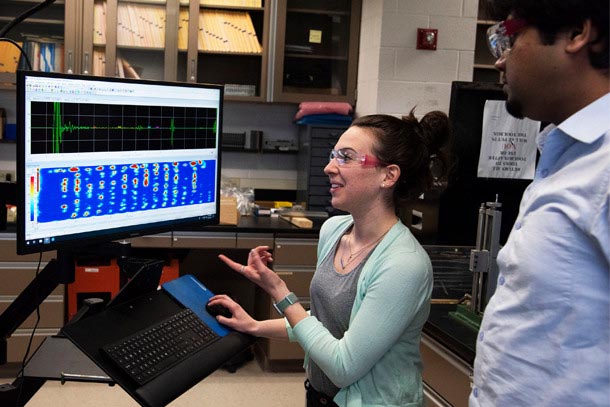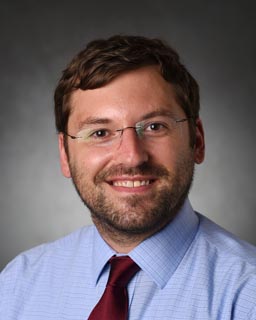
In this photo taken in the Penn State Ultrasonics Lab in 2019, researchers demonstrate the technology used to analyze wave propagation data. IMAGE: ANDREA ARGUELLES
Engineers investigate additive manufacturing quality control with grant from 3M
9/29/2020
By Gabrielle Stewart
UNIVERSITY PARK, Pa. — An interdisciplinary team of researchers in Penn State’s College of Earth and Mineral Sciences and College of Engineering was awarded a $180,000 grant to investigate comprehensive quality control methods for additive manufacturing (AM), or 3D printing, of metals.
The grant is renewable for up to three years, for a total of $540,000, as part of a Penn State agreement with 3M.
“3M is funding the grant but, more importantly, the company will be a close collaborator on this project,” said Allison Beese, principal investigator and associate professor of materials science and engineering in the College of Earth and Mineral Sciences. “The Penn State researchers will ensure scientific rigor, while 3M — a leader in industrial additive manufacturing — will guide industry relevancy, continuing to build the strong partnership between 3M and Penn State.”
Using nondestructive evaluation (NDE), a method for examining or testing a part or system without causing harm, the researchers will assess 3D printed parts. They are specifically investigating binder jetting, an AM process involving the repeated layering of powder particles and an adhesive.
“We’re trying to develop a detailed scientific understanding of how to link the binder-jet process to the microstructure and the quality of the part,” Beese said. “At the end of the day, someone should be able to use NDE to evaluate a part to determine if the part is suitable for use and know exactly what in its microstructure results in good or bad properties.”
Current evaluation processes take place part by part. After a batch is made, a sample part’s properties are tested to determine whether the part — and therefore the batch — is sufficient and safe for use. Whether a part succeeds or fails, it is not evaluated further and no cause for the part’s failure or success is identified.
To assess AM parts more comprehensively, the researchers will investigate links between the processes used, microstructure of the parts and mechanical properties like hardness, tensile strength and ductility. Making connections between process, structure, property and performance (PSPP) will allow the researchers to understand why parts fail more thoroughly and infer improved methods of manufacturing.
Ultrasonic NDE will assist in this process, according to Beese. Using this method, researchers send ultrasonic waves into a material and examine their movement to identify microscopic features and flaws in the structure of a part that in turn dictate the part’s mechanical performance.
The group can benefit from this information in two ways. First, a thorough analysis of a part’s microstructure can assist researchers in predicting performance failures or successes before they happen — and when they do, they support the researchers’ inferences and allow them to draw conclusions. Secondly, understanding PSPP connections informs the researchers on redesign, providing them with insight on how changes to the manufacturing process and material will influence the final product.
Models will serve as valuable tools for the team’s analysis process.
“We aim to develop models that link ultrasonic measurements to microstructure and collaborate with Dr. Beese to connect the microstructure analysis to mechanical properties,” said Andrea Arguelles, co-principal investigator and assistant professor of engineering science and mechanics. “Our ultimate goal is to develop an ultrasonic method and model that will provide manufacturers with a prediction for a part’s performance.”
Arguelles and co-principal investigator Christopher Kube, assistant professor of engineering science and mechanics, will contribute their expertise of ultrasonic measurement and computational analysis to the research, while Beese will provide insights on how the identified and analyzed features affect the mechanical properties and ultimate application potential of a part.
“Ultrasound is a traditional tool to assess the quality of structural components that have already been fabricated,” Kube said. “This project, however, is unique in that ultrasound is being used parallel to the material development process to accelerate toward high-quality structural components.”





